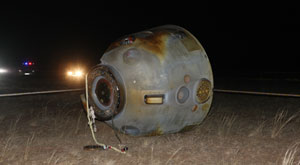China Fulfils Space Docking Mission as Shenzhou-8 Returns
Xinhua News Agency, November 18, 2011 Adjust font size:
China wrapped up its first-ever space docking mission Thursday upon return of the unmanned spacecraft Shenzhou-8, leaping towards the nation's ambition of building a permanent manned space station in around 2020.
Shenzhou-8, aided in the air by a parachute, landed in Siziwang Banner (county) in north China's Inner Mongolia Autonomous Region at around 7:30 PM, marking the end of the 49-day space docking mission that is hoped to pave the way for the establishment of the nation's own space station.
Chang Wanquan, commander-in-chief of the manned space program, announced at the Beijing Aerospace Control Center (BACC) that the space docking mission was a "complete success."
"The whole procedure of space docking -- from the launches of both Tiangong-1 and Shenzhou-8 into orbits, the two docking tests, to Shenzhou-8 return -- was flawless," said Zhou Jianping, chief designer of the manned space program.
"We have not only made a breakthrough in space docking technologies, but also validated the capability of the rocket, the spacecraft as well as the whole system, laying a solid foundation for the building of a space station," Zhou said at the BACC after watching the return of Shenzhou-8.
"Technically, I would give the mission full marks," he said.
Shortly after the landing, Vice Premier Zhang Dejiang, who also observed the return of Shenzhou-8 at the BACC, delivered a congratulatory note issued by the central authorities.
The successful rendezvous and docking between the target orbiter Tiangong-1 and the Shenzhou-8 spacecraft marks a significant breakthrough in China's space docking technology, and it is also a great leap in China's aerospace technologies, Zhang said.
It is an important milestone in the history of China's manned space program, and a landmark in China's pursuit of transforming itself into a country of innovation, Zhang said.
Launched from the Jiuquan Satellite Launch Center on Nov. 1, Shenzhou-8 first rendezvoused and docked with the target orbiter Tiangong-1 two days later. The two joint vessels then orbited earth for 12 days and conducted another docking after disengagement on Nov. 14.
Tiangong-1, which blasted off from the same launch site on Sept. 29, will remain in orbit to await docking attempts of both Shenzhou-9 and Shenzhou-10 in 2012. At least one of the two space vessels will take astronauts.
Three-phase manned program
China initiated its three-phase manned program in 1992. During the first phase, astronaut Yang Liwei became the first of the nation in 2003 to be in space on Shenzhou-5.
After Chinese astronauts made successful extravehicular activities during the Shenzhou-7 mission in 2008, China started the second phase of the space program: space docking.
After the planned Shenzhou-9 and Shenzhou-10 missions both in 2012, China will build a space lab around 2016, which will mark the end of the second phase.
In the third stage, China plans to develop and launch multiple space modules, with a goal of assembling a 60-tonne space station in around 2020. Chinese astronauts will operate more space research projects.
The assembly of the China-made space station will come at a time when the International Space Station (ISS), which was jointly initiated by the United States and Russia, will likely retire.
Chief designer Zhou said China will turn its future space station into a platform for international cooperation on space research and applications.
"The Chinese space exploration will benefit well-being of all humanity," Zhou said.


